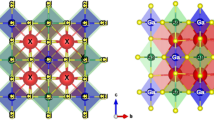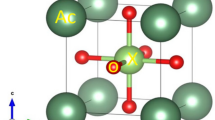Abstract
In this work, methylammonium bismuth iodide [(CH3NH3)3Bi2I9] has been synthesized through the mechanochemical process. Indeed, (CH3NH3)3Bi2I9 emerges as promising alternative to lead-based inorganic–organic perovskite due to low toxicity and better stability. X-ray diffraction spectra reveal monoclinic structure of (CH3NH3)Bi2I9 with space group C2/c. Kubelka–Munk method is conducted to compute the bandgap (2.16 eV). The impedance and dielectric properties of (CH3NH3)3Bi2I9 have been investigated within frequency range of 4 Hz to 1 MHz for several temperatures in between 333 to 453 K. The complex impedance spectroscopy has analyzed by fitting the Cole–Cole plot with suitable grain and grain boundary contributions (rg, rgb). Conductivity and electric modulus spectra have been analyzed to enlight the shaded portion of transportation properties. The scaled coordination of modulus spectrum merges in a single master curve which signifies that the distribution of relaxation time is temperature independent. To compute the DC conductivity, AC conductivity data have fitted using Jonscher’s power law. The activation energy calculated from Arrhenius plot is 0.477 eV.






Similar content being viewed by others
References
J. Liu, M. Yao, L. Shen, Third generation photovoltaic cells based on photonic crystals. J. Mater. Chem. C 7, 3121–3145 (2019). https://doi.org/10.1039/c8tc05461d
M. Neukom, S. Züfle, S. Jenatsch, B. Ruhstaller, Opto-electronic characterization of third-generation solar cells. Sci. Technol. Adv. Mater. 19, 291–316 (2018). https://doi.org/10.1080/14686996.2018.1442091
A. Sharma, N.B. Chaure, Studies on CH3NH3PbI3 prepared by low-cost wet chemical technique. Appl. Phys. A Mater. Sci. Process. 125, 1–7 (2019). https://doi.org/10.1007/s00339-019-3047-1
P. Sadhukhan, S. Kundu, A. Roy, A. Ray, P. Maji, H. Dutta, S.K. Pradhan, S. Das, Solvent-free solid-state synthesis of high yield mixed halide perovskites for easily tunable composition and band gap. Cryst. Growth Des. 18, 3428–3432 (2018). https://doi.org/10.1021/acs.cgd.8b00137
S.D. Stranks, G.E. Eperon, G. Grancini, C. Menelaou, M.J.P. Alcocer, T. Leijtens, L.M. Herz, A. Petrozza, H.J. Snaith, Electron-hole diffusion lengths exceeding. Science 342, 341–345 (2013)
L. Liang, P. Gao, Lead-free hybrid perovskite absorbers for viable application: can we eat the cake and have it too? Adv. Sci. (2018). https://doi.org/10.1002/advs.201700331
S.-W. Lee, S. Kim, S. Bae, K. Cho, T. Chung, L.E. Mundt, S. Lee, S. Park, H. Park, M.C. Schubert, S.W. Glunz, Y. Ko, Y. Jun, Y. Kang, H.-S. Lee, D. Kim, UV degradation and recovery of perovskite solar cells—supplementary information. Sci. Rep. 6, 38150 (2016). https://doi.org/10.1038/srep38150
H.S. Kim, J.Y. Seo, N.G. Park, Material and device stability in perovskite solar cells. Chemsuschem 9, 2528–2540 (2016). https://doi.org/10.1002/cssc.201600915
M. Lyu, J.H. Yun, M. Cai, Y. Jiao, P.V. Bernhardt, M. Zhang, Q. Wang, A. Du, H. Wang, G. Liu, L. Wang, Organic–inorganic bismuth (III)-based material: a lead-free, air-stable and solution-processable light-absorber beyond organolead perovskites. Nano Res. 9, 692–702 (2016). https://doi.org/10.1007/s12274-015-0948-y
M. Lyu, J.H. Yun, P. Chen, M. Hao, L. Wang, Addressing toxicity of lead: progress and applications of low-toxic metal halide perovskites and their derivatives. Adv. Energy Mater. (2017). https://doi.org/10.1002/aenm.201602512
V. Sarritzu, N. Sestu, D. Marongiu, X. Chang, S. Masi, A. Rizzo, S. Colella, F. Quochi, M. Saba, A. Mura, G. Bongiovanni, Optical determination of Shockley–Read–Hall and interface recombination currents in hybrid perovskites. Sci. Rep. 7, 1–10 (2017). https://doi.org/10.1038/srep44629
R.L.Z. Hoye, P. Schulz, L.T. Schelhas, A.M. Holder, K.H. Stone, J.D. Perkins, D. Vigil-Fowler, S. Siol, D.O. Scanlon, A. Zakutayev, A. Walsh, I.C. Smith, B.C. Melot, R.C. Kurchin, Y. Wang, J. Shi, F.C. Marques, J.J. Berry, W. Tumas, S. Lany, V. Stevanović, M.F. Toney, T. Buonassisi, Perovskite-inspired photovoltaic materials: toward best practices in materials characterization and calculations. Chem. Mater. 29, 1964–1988 (2017). https://doi.org/10.1021/acs.chemmater.6b03852
A. Jain, K.A. Persson, G. Ceder, Research update: the materials genome initiative: data sharing and the impact of collaborative ab initio databases. APL Mater. (2016). https://doi.org/10.1063/1.4944683
R.E. Brandt, V. Stevanović, D.S. Ginley, T. Buonassisi, Identifying defect-tolerant semiconductors with high minority-carrier lifetimes: beyond hybrid lead halide perovskites. MRS Commun. 5, 265–275 (2015). https://doi.org/10.1557/mrc.2015.26
L.C. Lee, T.N. Huq, J.L. Macmanus-Driscoll, R.L.Z. Hoye, Research update: bismuth-based perovskite-inspired photovoltaic materials. APL Mater. 6, 12–14 (2018). https://doi.org/10.1063/1.5029484
R. Pamphlett, G. Danscher, J. Rungby, M. Stoltenberg, Tissue uptake of bismuth from shotgun pellets. Environ. Res. 82, 258–262 (2000)
M. Abulikemu, S. Ould-Chikh, X. Miao, E. Alarousu, B. Murali, G.O. Ngongang Ndjawa, J. Barbé, A. El Labban, A. Amassian, S. Del Gobbo, Optoelectronic and photovoltaic properties of the air-stable organohalide semiconductor (CH3NH3)3Bi2I9. J. Mater. Chem. A. 4, 12504–12515 (2016). https://doi.org/10.1039/c6ta04657f
D. Priante, I. Dursun, M.S. Alias, D. Shi, V.A. Melnikov, T.K. Ng, O.F. Mohammed, O.M. Bakr, B.S. Ooi, The recombination mechanisms leading to amplified spontaneous emission at the true-green wavelength in CH3NH3PbBr3 perovskites. Appl. Phys. Lett. 106, 1–5 (2015). https://doi.org/10.1063/1.4913463
R.L.Z. Hoye, R.E. Brandt, A. Osherov, V. Stevanovic, S.D. Stranks, M.W.B. Wilson, H. Kim, A.J. Akey, J.D. Perkins, R.C. Kurchin, J.R. Poindexter, E.N. Wang, M.G. Bawendi, V. Bulovic, T. Buonassisi, Methylammonium bismuth iodide as a lead-free, stable hybrid organic-inorganic solar absorber. Chem. A Eur. J. 22, 2605–2610 (2016). https://doi.org/10.1002/chem.201505055
R. López, R. Gómez, Band-gap energy estimation from diffuse reflectance measurements on sol-gel and commercial TiO2: a comparative study. J. Sol-Gel Sci. Technol. 61, 1–7 (2012). https://doi.org/10.1007/s10971-011-2582-9
B.W. Park, B. Philippe, X. Zhang, H. Rensmo, G. Boschloo, E.M.J. Johansson, Bismuth based hybrid perovskites A3Bi2I9 (A: methylammonium or cesium) for solar cell application. Adv. Mater. 27, 6806–6813 (2015). https://doi.org/10.1002/adma.201501978
H. Rahmouni, M. Smari, B. Cherif, E. Dhahri, K. Khirouni, Conduction mechanism, impedance spectroscopic investigation and dielectric behavior of La0.5Ca0.5-xAgxMnO3 manganites with compositions below the concentration limit of silver solubility in perovskites (0 ≤ x ≤ 0.2). Dalton Trans. 44, 10457–10466 (2015). https://doi.org/10.1039/c5dt00444f
P. Maji, S. Chatterjee, S. Das, Study on charge transportation and scaling behavior of CsPbI3 microwires. Ceram. Int. 45, 6012–6020 (2019). https://doi.org/10.1016/j.ceramint.2018.12.071
D.K. Pattanayak, R.K. Parida, N.C. Nayak, A.B. Panda, B.N. Parida, Optical and transport properties of new double perovskite oxide. J. Mater. Sci. Mater. Electron. 29, 6215–6224 (2018). https://doi.org/10.1007/s10854-018-8597-z
D.K. Pradhan, P. Misra, V.S. Puli, S. Sahoo, D.K. Pradhan, R.S. Katiyar, Studies on structural, dielectric, and transport properties of Ni0.65Zn0.35Fe2O4. J. Appl. Phys. 115, 243904 (2014). https://doi.org/10.1063/1.4885420
M.S. Sheikh, A.P. Sakhya, A. Dutta, T.P. Sinha, Dielectric relaxation of CH3NH3PbI3 thin film. Thin Solid Films 638, 277–281 (2017). https://doi.org/10.1016/j.tsf.2017.07.070
Y. Mateyshina, A. Slobodyuk, V. Kavun, N. Uvarov, Conductivity and NMR study of composite solid electrolytes CsNO2-A (A = SiO2, Al2O3, MgO). Solid State Ionics 324, 196–201 (2018). https://doi.org/10.1016/j.ssi.2018.04.026
T. Wang, J. Hu, H. Yang, L. Jin, X. Wei, C. Li, F. Yan, Y. Lin, Dielectric relaxation and Maxwell–Wagner interface polarization in Nb2O5 doped 0.65BiFeO3-0.35BaTiO3 ceramics. J. Appl. Phys. 121, 084103 (2017). https://doi.org/10.1063/1.4977107
M.R. Das, A. Mukherjee, P. Mitra, Structural, optical and electrical characterization of CBD synthesized CdO thin films: influence of deposition time. Mater. Sci. Pol. 35, 470–478 (2017). https://doi.org/10.1515/msp-2017-0063
L. Zhang, Z.J. Tang, Polaron relaxation and variable-range-hopping conductivity in the giant-dielectric-constant material CaCu3Ti4O12. Phys. Rev. B Condens. Matter Mater. Phys. 70, 1–6 (2004). https://doi.org/10.1103/PhysRevB.70.174306
M. Venkateswarlu, K. Narasimha Reddy, B. Rambabu, N. Satyanarayana, A.C. conductivity and dielectric studies of silver-based fast ion conducting glass system. Solid State Ionics 127, 177–184 (2000). https://doi.org/10.1016/S0167-2738(99)00257-X
R.J. Sengwa, P. Dhatarwal, S. Choudhary, Study of time-ageing effect on the ionic conduction and structural dynamics in solid polymer electrolytes by dielectric relaxation spectroscopy. Solid State Ionics 324, 247–259 (2018). https://doi.org/10.1016/j.ssi.2018.07.015
A. Molak, M. Paluch, S. Pawlus, J. Klimontko, Z. Ujma, I. Gruszka, Electric modulus approach to the analysis of electric relaxation in highly conducting (Na0.75Bi0.25)(Mn0.25Nb0.75)O3 ceramics. J. Phys. D. Appl. Phys. 38, 1450–1460 (2005). https://doi.org/10.1088/0022-3727/38/9/019
B. Harihara Venkataraman, K.B.R. Varma, Frequency-dependent dielectric characteristics of ferroelectric SrBi2Nb2O9 ceramics. Solid State Ionics 167, 197–202 (2004). https://doi.org/10.1016/j.ssi.2003.12.020
H. Yamamura, S. Takeda, K. Kakinuma, Dielectric relaxations in the Ce1-xNdxO2-δ system. Solid State Ionics 178, 1059–1064 (2007). https://doi.org/10.1016/j.ssi.2007.05.010
P. Maji, A. Ray, P. Sadhukhan, A. Roy, S. Das, Fabrication of symmetric supercapacitor using cesium lead iodide (CsPbI3) microwire. Mater. Lett. 227, 268–271 (2018). https://doi.org/10.1016/j.matlet.2018.05.101
R. Kaur, V. Sharma, M. Kumar, M. Singh, A. Singh, Conductivity relaxation in solid solution in Pb0.9Sm0.10Zr0.405Ti0.495Fe0.10O3 solid solution. J. Alloys Compd. 735, 1472–1479 (2018). https://doi.org/10.1016/j.jallcom.2017.11.254
A. Kaur, L. Singh, K. Asokan, Electrical relaxation and conduction mechanisms in iron doped barium strontium titanate. Ceram. Int. 44, 3751–3759 (2018). https://doi.org/10.1016/j.ceramint.2017.11.158
R. Tang, C. Jiang, W. Qian, J. Jian, X. Zhang, H. Wang, H. Yang, Dielectric relaxation, resonance and scaling behaviors in Sr3Co2Fe24O41 hexaferrite. Sci. Rep. 5, 1–11 (2015). https://doi.org/10.1038/srep13645
M.R. Anantharaman, K.A. Malini, S. Sindhu, E.M. Mohammed, S.K. Date, S.D. Kulkarni, P.A. Joy, P. Kurian, Tailoring magnetic and dielectric properties of rubber ferrite composites containing mixed ferrites. Bull. Mater. Sci. 24, 623–631 (2001). https://doi.org/10.1007/BF02704011
S.K. Badge, A.V. Deshpande, Study of dielectric and ferroelectric properties of bismuth titanate (Bi4Ti3O12) ceramic prepared by sol-gel synthesis and solid state reaction method with varying sintering temperature. Solid State Ionics 334, 21–28 (2019). https://doi.org/10.1016/j.ssi.2019.01.028
M.S. Sheikh, A.P. Sakhya, P. Sadhukhan, A. Dutta, S. Das, T.P. Sinha, Dielectric relaxation and Ac conductivity of perovskites CH3NH3PbX3 (X = Br, I). Ferroelectrics 514, 146–157 (2017). https://doi.org/10.1080/00150193.2017.1359023
S. Selvasekarapandian, M. Vijayakumar, Frequency-dependent conductivity and dielectric studies on LixV2O5 (x=0.6–1.6). Solid State Ionics 148, 329–334 (2002). https://doi.org/10.1016/S0167-2738(02)00070-X
S. Sarangi, T. Badapanda, B. Behera, S. Anwar, Frequency and temperature dependence dielectric behavior of barium zirconate titanate nanocrystalline powder obtained by mechanochemical synthesis. J. Mater. Sci. Mater. Electron. 24, 4033–4042 (2013). https://doi.org/10.1007/s10854-013-1358-0
A. Ray, A. Roy, S. De, S. Chatterjee, S. Das, Frequency and temperature dependent dielectric properties of TiO2-V2O5 nanocomposites. J. Appl. Phys. (2018). https://doi.org/10.1063/1.5012586
A. Ray, A. Roy, S. Bhattacharjee, S. Jana, C.K. Ghosh, C. Sinha, S. Das, Correlation between the dielectric and electrochemical properties of TiO2-V2O5 nanocomposite for energy storage application. Electrochim. Acta. 266, 404–413 (2018). https://doi.org/10.1016/j.electacta.2018.02.033
A.K. Roy, A. Singh, K. Kumari, K. Amar Nath, A. Prasad, K. Prasad, Electrical properties and AC conductivity of (Bi0.5Na0.5)0.94Ba0.06TiO3 ceramic. ISRN Ceram. 2012, 1–10 (2012). https://doi.org/10.5402/2012/854831
D.K. Pradhan, R.N.P. Choudhary, C. Rinaldi, R.S. Katiyar, Effect of Mn substitution on electrical and magnetic properties of Bi0.9La0.1FeO3. J. Appl. Phys. (2009). https://doi.org/10.1063/1.3158121
S. Mukherjee, S. Chatterjee, S. Rayaprol, S.D. Kaushik, S. Bhattacharya, P.K. Jana, Near room temperature magnetodielectric consequence in (Li, Ti) doped NiO ceramic. J. Appl. Phys. (2016). https://doi.org/10.1063/1.4945318
A.K. Jonscher, The ‘Universal’ dielectric response. Nature 267(5613), 673–679 (1977)
T. Paul, A. Ghosh, Structural and electrical transport properties of La2Mo2O9 thin films prepared by pulsed laser deposition. J. Appl. Phys. (2017). https://doi.org/10.1063/1.4979881
T. Okiba, K. Shozugawa, M. Matsuo, T. Hashimoto, On crystal structure and electrical conduction properties. Solid State Ionics 346, 115191 (2020). https://doi.org/10.1016/j.ssi.2019.115191
F.B. Abdallah, A. Benali, S. Azizi, M. Triki, E. Dhahri, M.P.F. Graça, M.A. Valente, Strontium-substituted La0.75Ba0.25–xSrxFeO3 (x = 0.05, 0.10 and 0.15) perovskite: dielectric and electrical studies. J. Mater. Sci. Mater. Electron. 30, 8457–8470 (2019). https://doi.org/10.1007/s10854-019-01166-7
Acknowledgements
This work is financially supported by the Department of Science and Technology and Bio-Technology, Government of West Bengal [247(Sanc.)/ST/P/S&T/16G-36/2017 dated 25/03/2018; PI- S Das]. P. Sadhukhan acknowledges DST, Gov. of India for the INSPIRE fellowship (IF160132).
Author information
Authors and Affiliations
Corresponding author
Additional information
Publisher's Note
Springer Nature remains neutral with regard to jurisdictional claims in published maps and institutional affiliations.
Rights and permissions
About this article
Cite this article
Pujaru, S., Maji, P., Sadhukhan, P. et al. Dielectric relaxation and charge conduction mechanism in mechanochemically synthesized methylammonium bismuth iodide. J Mater Sci: Mater Electron 31, 8670–8679 (2020). https://doi.org/10.1007/s10854-020-03402-x
Received:
Accepted:
Published:
Issue Date:
DOI: https://doi.org/10.1007/s10854-020-03402-x




